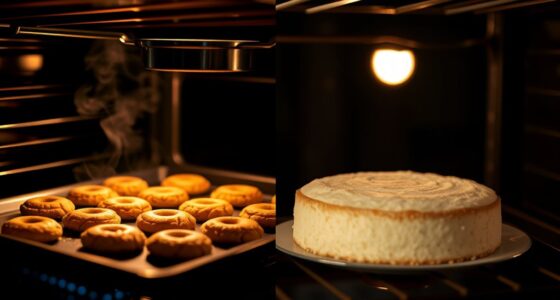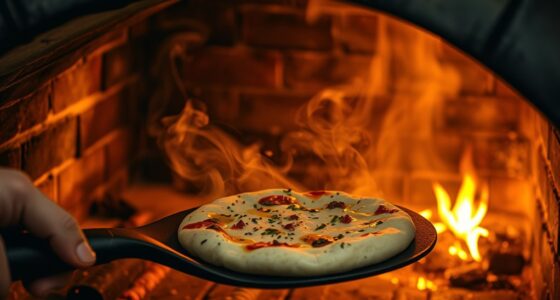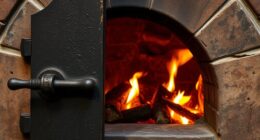When choosing between stone, steel, and cordierite, consider durability, heat retention, and versatility. Stone offers aesthetic appeal and excellent heat retention for slow cooking but heats slowly and can crack with thermal shocks. Steel heats quickly, resists damage, and is great for searing, but may lose heat faster. Cordierite balances durability and heat retention, ideal for baking and versatile cooking. Explore the details to find the best fit for your kitchen needs.
Key Takeaways
- Stone offers superior heat retention and natural aesthetic, ideal for slow cooking and baking.
- Steel heats rapidly, providing precise control, suitable for high-temperature searing and quick cooking.
- Cordierite balances durability and even heat distribution, making it versatile for baking and stone-cooked dishes.
- Stone and cordierite are more expensive but excel in heat retention; steel is cost-effective with quick responsiveness.
- Proper maintenance—avoiding rapid temperature changes and using gentle cleaning—extends the lifespan of all three materials.
Comparing Durability and Heat Retention

When it comes to durability and heat retention, each material offers distinct advantages. Stone provides excellent aesthetic appeal, with a natural look that ages beautifully, and retains heat evenly thanks to its density. It’s highly durable, resisting chips and cracks over time. Steel, on the other hand, boasts impressive strength, making it resistant to warping and damage, though its aesthetic appeal is more modern and sleek. Steel heats up quickly and distributes heat efficiently, but it may lose heat faster than stone. Cordierite strikes a balance; it’s resilient and resistant to thermal shock, maintaining consistent heat distribution, and has a unique rustic charm. Overall, your choice depends on whether durability, aesthetic appeal, or heat retention is your priority.
Cooking Performance and Versatility
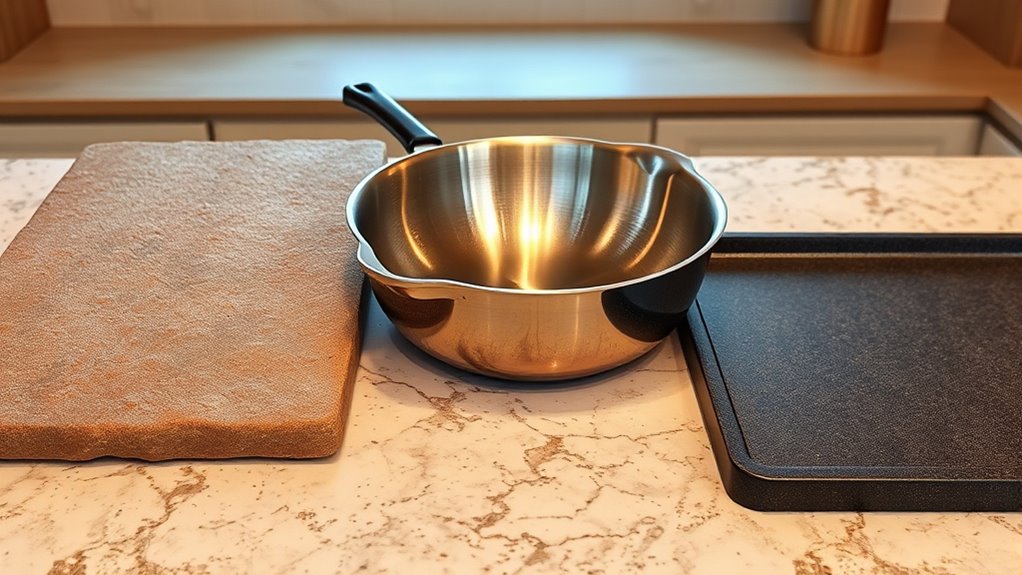
Each material’s ability to support a variety of cooking styles greatly influences its versatility. Stone offers excellent heat retention, giving you steady temperature control for slow cooking or baking. Its aesthetic appeal adds rustic charm, but it can be slow to heat up and less responsive to temperature adjustments. Steel heats quickly and provides precise temperature control, making it ideal for high-heat techniques like searing or stir-frying. Its sleek, modern look enhances aesthetic appeal, and its responsiveness allows for quick adjustments. Cordierite strikes a balance, heating evenly and retaining heat well, which supports diverse cooking methods. Its versatility is complemented by its attractive appearance, blending durability with visual appeal. Additionally, the thermal conductivity of each material influences how quickly and evenly heat distributes during cooking. Overall, your choice depends on whether you prioritize quick responsiveness, steady heat, or a blend of both for different culinary needs.
Maintenance and Longevity

Maintenance requirements and longevity vary considerably among stone, steel, and cordierite cookware. Stone pieces often boast impressive stone aesthetics but need gentle cleaning to prevent surface damage. Steel cookware resists corrosion but can develop rust if neglected, so regular drying is essential. Cordierite is durable but prone to cracking under sudden temperature changes, impacting longevity. Additionally, AI discoveries in material manipulation suggest that future cookware could incorporate AI-enhanced materials to improve durability and heat retention.
To keep your cookware in top shape:
- Clean stone surfaces with soft cloths, avoiding abrasive cleaners
- Dry steel thoroughly after washing to prevent steel corrosion
- Avoid rapid temperature shifts with cordierite
- Use non-metal utensils to preserve stone aesthetics
- Regularly inspect for cracks or chips in cordierite
Understanding these maintenance tips helps maximize each material’s lifespan and performance.
Cost and Value for Money

Understanding the price differences between stone, steel, and cordierite can help you make smarter choices. Consider how their durability and longevity impact overall value for money. By comparing these factors, you’ll find the option that offers the best balance of cost and performance. Additionally, investing in automation technologies can further enhance operational efficiency and long-term savings.
Price Comparison Chart
How do stone, steel, and cordierite compare when it comes to price and value for money? Typically, steel offers the most affordable pricing options, making it appealing if you’re budget-conscious. Cordierite tends to be mid-range, balancing cost with good performance, while stone often carries a higher price tag due to its premium feel and natural appeal. When evaluating value, consider brand reputation—trusted brands may cost more but usually provide better quality and warranties. Here’s a quick comparison:
- Steel: Cheapest, reliable, widely available
- Cordierite: Moderate price, versatile, durable
- Stone: Highest cost, premium aesthetics
Pricing options vary by brand reputation and features. Investing in a reputable brand can save money long-term. Additionally, understanding the importance of leadership skills in making strategic purchasing decisions can enhance your ability to select the best option for your needs.
Durability and Longevity
When it comes to durability and longevity, steel generally outperforms stone and cordierite, offering reliable performance over time. Its high material strength resists warping, cracking, and damage, ensuring your investment lasts longer. Steel surfaces are less prone to wear from heat and everyday use, making them a smart choice for long-term value. While stone and cordierite can look attractive initially, their aesthetic appeal may diminish as chips or cracks develop over time, reducing their visual appeal. Steel’s robustness means minimal maintenance and fewer replacements, giving you better cost efficiency. If durability and longevity are your priorities, steel provides the strongest material strength and consistent aesthetic appeal over the years, making it a practical choice for long-term use.
Suitable Cooking Styles and Recipes
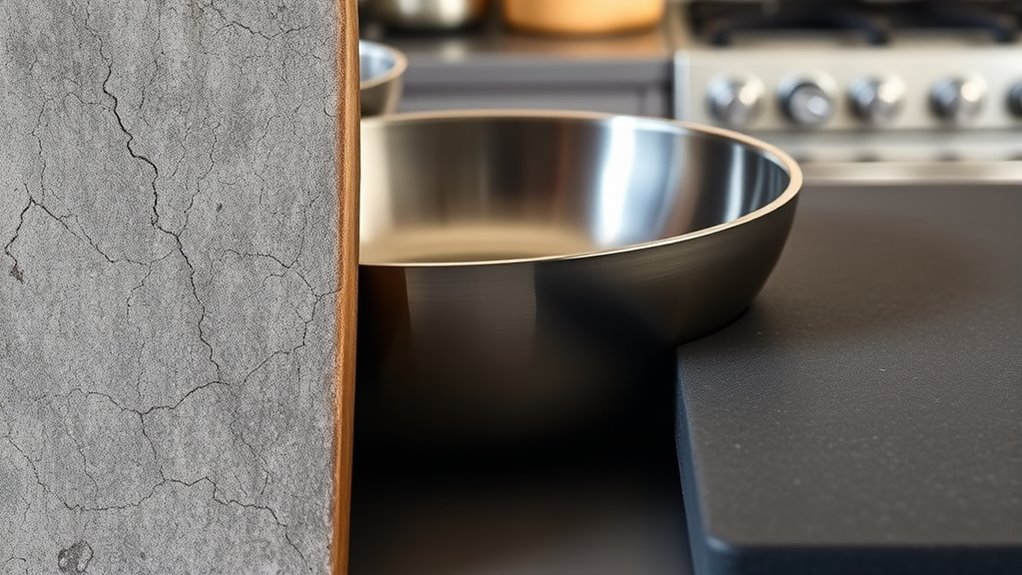
Choosing the right cooking surface can considerably influence the style of recipes you prepare. Stone surfaces excel at retaining heat, making them ideal for rustic bread baking or slow-cooked stews. Steel surfaces are versatile and respond quickly to temperature changes, perfect for searing meats or stir-fries. Cordierite offers excellent heat retention with minimal steel corrosion concerns, suitable for baking pizzas or baking stones. Keep in mind that stone heat provides gentle, even warmth, while steel heats up rapidly but requires careful temperature management. Recipes that benefit from steady, consistent heat are best on stone or cordierite, whereas quick-cooking techniques suit steel. Understanding these nuances helps you match your cookware to your preferred cooking styles and recipes. Proper heat retention is essential for achieving optimal results with each surface type.
Environmental Impact and Sustainability
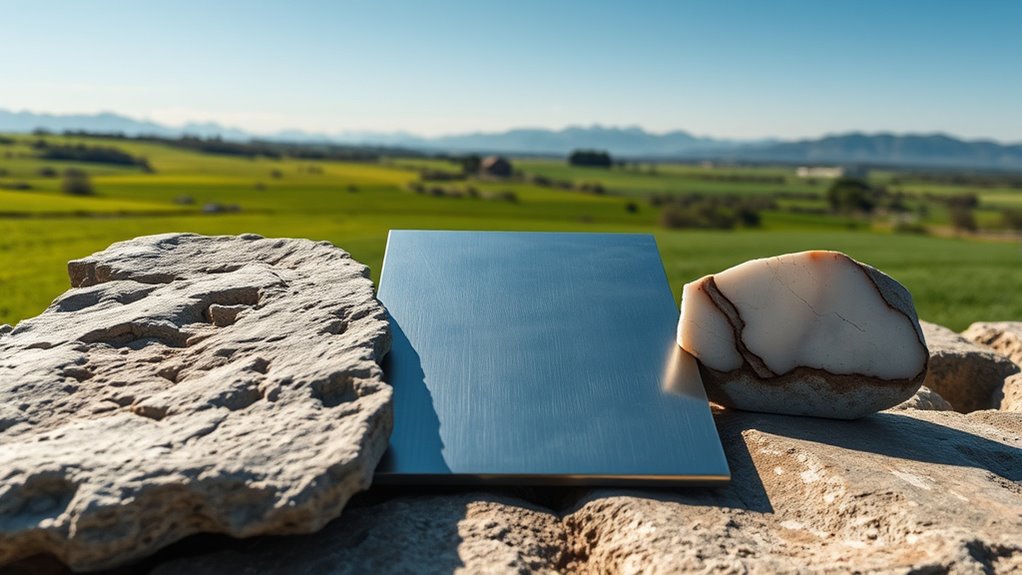
Selecting a cooking surface involves considering not just performance but also its environmental footprint. Eco friendly materials are increasingly important, as they reduce the strain on natural resources and minimize pollution. Stone, steel, and cordierite each have different impacts; stone can be sourced sustainably if responsibly mined, while steel is highly recyclable, offering excellent recycling potential. Cordierite, made from natural minerals, typically has a lower environmental impact during production, but its recycling potential is limited. Choosing a surface with a lower carbon footprint supports sustainability efforts and helps reduce waste. By prioritizing eco friendly materials and understanding recycling potential, you can make more environmentally conscious choices that align with your values and promote a healthier planet. Additionally, personality traits like conscientiousness can influence how diligently individuals pursue environmentally sustainable options in their daily choices.
Frequently Asked Questions
Which Material Heats up the Fastest?
Steel heats up the fastest because it has the highest thermal conductivity among these materials, allowing heat to transfer quickly. While steel heats rapidly, it doesn’t retain heat as well as stone or cordierite. If you want quick heating, steel’s your best choice, but if heat retention matters more, stone or cordierite will serve you better. Keep in mind, the material’s thermal properties directly influence how fast it heats up and retains heat.
Can These Materials Be Used Outdoors?
You can definitely use these materials outdoors, especially if weather resistance matters. For example, a homeowner installed a steel grill in their backyard, enjoying its durability against rain and sun. Steel offers excellent weather resistance and a sleek aesthetic appeal, making it suitable for outdoor setups. Stone and cordierite can also withstand outdoor conditions if properly treated, but steel generally offers the most longevity and visual impact in exposed environments.
Are There Health Risks Associated With Each Material?
You should be aware of health concerns related to each material’s safety. Stone, steel, and cordierite generally pose minimal risks when used properly, but handling them may expose you to dust or particles that can irritate your lungs or skin. Always wear protective gear, like masks and gloves, and work in well-ventilated areas. Proper cleaning and maintenance also help guarantee safe use, reducing potential health risks.
How Do They Perform at High Altitudes?
At high altitudes, your choice of stone, steel, or cordierite affects altitude performance and weather resilience. Steel heats quickly and maintains consistent temperatures, making it reliable in cold, high-altitude conditions. Cordierite offers excellent heat retention and weather resilience, but may crack under thermal stress. Stone provides stability but can be less responsive to temperature changes. Choose based on your need for durability, heat retention, and resilience in challenging weather.
Do They Require Special Storage Conditions?
You should store these materials in a cool, dry place to prevent damage. Proper storage requirements involve avoiding extreme temperatures and humidity, which can compromise their integrity. Use preservation techniques like airtight containers or cushioned containers to protect against physical damage and environmental factors. Regularly check conditions, especially if you’re in high-altitude areas, to guarantee they remain in good shape and perform reliably when needed.
Conclusion
Choosing between stone, steel, and cordierite depends on what you prioritize. If you want unbeatable heat retention, stone might be your hero. For durability and versatility, steel’s your go-to. Cordierite offers a perfect balance, but none can match the legendary performance of a well-maintained piece. Ultimately, your choice shapes your cooking universe—making it as epic as a culinary legend in the making. Pick wisely, and turn your kitchen into a flavor fortress!



